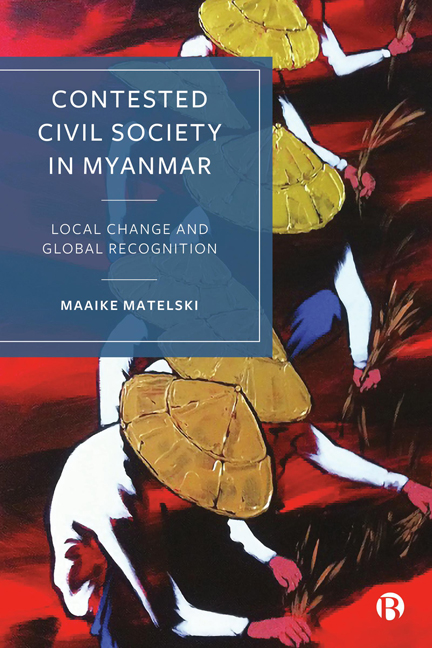Book contents
- Frontmatter
- Contents
- List of Abbreviations and Acronyms
- Acknowledgements
- Introduction: Contested Representation in Burma/Myanmar
- 1 Conflict, Repression and Resistance from Colonialism to Military Rule
- 2 Constructing Civil Society in Myanmar
- 3 Diversity and Fault Lines in Burmese Civil Society
- 4 Room to Manoeuvre under Authoritarian Rule
- 5 Transnational Advocacy Strategies and Pathways to Change
- 6 Competing Frames around the 2010 Elections
- 7 Foreign Aid and the (De)politicization of Civil Society Assistance
- 8 Interrupted Transition and Post-coup Resistance
- Conclusion
- Notes
- References
- Index
5 - Transnational Advocacy Strategies and Pathways to Change
Published online by Cambridge University Press: 28 March 2024
- Frontmatter
- Contents
- List of Abbreviations and Acronyms
- Acknowledgements
- Introduction: Contested Representation in Burma/Myanmar
- 1 Conflict, Repression and Resistance from Colonialism to Military Rule
- 2 Constructing Civil Society in Myanmar
- 3 Diversity and Fault Lines in Burmese Civil Society
- 4 Room to Manoeuvre under Authoritarian Rule
- 5 Transnational Advocacy Strategies and Pathways to Change
- 6 Competing Frames around the 2010 Elections
- 7 Foreign Aid and the (De)politicization of Civil Society Assistance
- 8 Interrupted Transition and Post-coup Resistance
- Conclusion
- Notes
- References
- Index
Summary
While the previous chapter focused on room to manoeuvre for civil society under authoritarian rule, the following chapters describe how Myanmar civil society actors framed their advocacy messages towards an international audience in their search for political, moral and financial support. In contrast to the volatile ‘under the radar’ activities described earlier, the transnational advocacy activities of the democracy movement called for a clear and simple message concerning the social and political problems in Myanmar and the question of who was responsible and how such problems could be addressed. Social movement theory holds that human rights advocacy messages are only partly determined by factual situations and feasible solutions. Other factors, such as the susceptibility of the target audience to certain messages, also play a role.
In contrast to many actors working under the radar during Myanmar’s early years of transition, as well as the more open engagement attempts of the Third Force towards the military, representatives of the democracy movement continued to openly oppose the government. The distinction between proponents and opponents of engaging the government, moreover, became more pronounced as the political transition unfolded. The occurrence of cyclone Nargis in 2008 not only led to a gradual emancipation of civil society actors based inside the country, but also resulted in the emergence of contrasting ‘frames’ about the benefits of distributing local aid. These frames became even more noticeable after elections had been announced for 2010, which further polarized both the political and the civil society landscape. Parallel to developments in the political sphere, those affiliated with the Third Force chose to call for participation in the elections, while those affiliated with the democracy movement boycotted the elections. This dichotomy was accentuated as both proponents and opponents of the elections attempted to reach out to the international community to influence foreign positions towards the Myanmar government. The contestations around the 2010 elections will be discussed in Chapter 6.
Although the elections formed the focal point of the disagreement over the government’s ‘Roadmap to Democracy’, some of the varying frames had already become visible in earlier debates. These include the question of economic sanctions, the evaluation of the 2008 constitution and the distribution of aid in the aftermath of cyclone Nargis.
- Type
- Chapter
- Information
- Contested Civil Society in MyanmarLocal Change and Global Recognition, pp. 90 - 102Publisher: Bristol University PressPrint publication year: 2023



